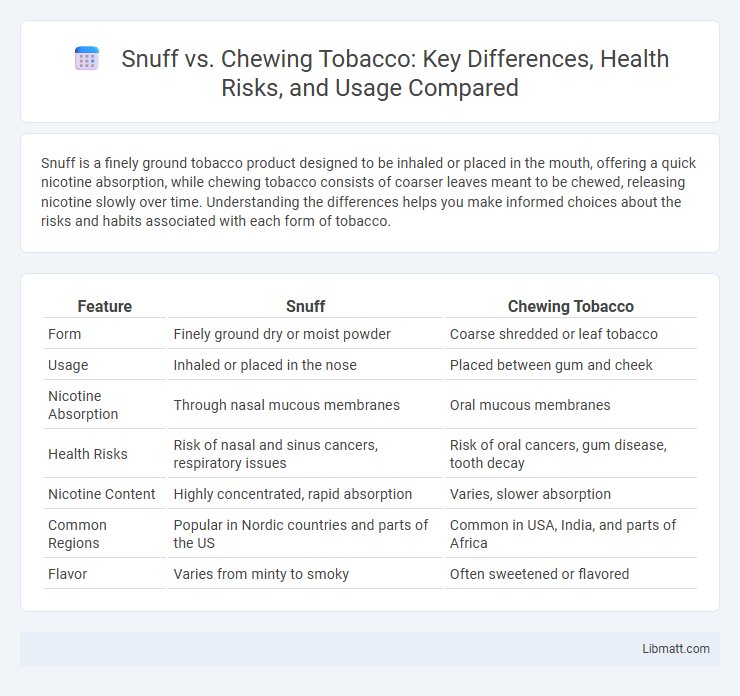Snuff is a finely ground tobacco product designed to be inhaled or placed in the mouth, offering a quick nicotine absorption, while chewing tobacco consists of coarser leaves meant to be chewed, releasing nicotine slowly over time. Understanding the differences helps you make informed choices about the risks and habits associated with each form of tobacco.
Table of Comparison
| Feature | Snuff | Chewing Tobacco |
|---|---|---|
| Form | Finely ground dry or moist powder | Coarse shredded or leaf tobacco |
| Usage | Inhaled or placed in the nose | Placed between gum and cheek |
| Nicotine Absorption | Through nasal mucous membranes | Oral mucous membranes |
| Health Risks | Risk of nasal and sinus cancers, respiratory issues | Risk of oral cancers, gum disease, tooth decay |
| Nicotine Content | Highly concentrated, rapid absorption | Varies, slower absorption |
| Common Regions | Popular in Nordic countries and parts of the US | Common in USA, India, and parts of Africa |
| Flavor | Varies from minty to smoky | Often sweetened or flavored |
Introduction to Smokeless Tobacco Products
Smokeless tobacco products include snuff and chewing tobacco, both widely used alternatives to smoking. Snuff is a finely ground or powdered tobacco that can be inhaled or placed inside the mouth, while chewing tobacco consists of larger tobacco leaves that users chew to release nicotine. These products deliver nicotine without combustion, but both pose significant health risks such as oral cancer, gum disease, and addiction.
What is Snuff?
Snuff is a finely ground smokeless tobacco product inhaled or placed inside the mouth between the gum and cheek, delivering nicotine without combustion. Unlike chewing tobacco, which requires chewing to release its nicotine, snuff offers a quicker nicotine absorption through the mucous membranes. Understanding the differences between these products can help you make informed decisions about tobacco use and its health implications.
What is Chewing Tobacco?
Chewing tobacco consists of coarsely ground or shredded tobacco leaves that users place between their cheek and gum to release nicotine through saliva absorption. Unlike snuff, which is finely ground and often inhaled nasally, chewing tobacco is designed for oral use, providing a slower nicotine release. Understanding your consumption method is crucial for assessing health risks associated with each form of tobacco.
Key Differences between Snuff and Chewing Tobacco
Snuff and chewing tobacco differ primarily in form and usage; snuff is finely ground tobacco inhaled through the nose, while chewing tobacco consists of coarser leaves meant to be chewed. Snuff delivers nicotine rapidly through nasal mucous membranes, whereas chewing tobacco releases nicotine more slowly via saliva absorption in the mouth. Your choice between these products should consider factors like ease of use, nicotine absorption rate, and potential health risks associated with each form.
Methods of Use: Snuff vs Chewing Tobacco
Snuff is typically inhaled through the nose or placed between the gum and lip, allowing nicotine absorption via nasal or oral mucous membranes. Chewing tobacco requires users to place the tobacco in the cheek pouch and chew or suck on it to release nicotine, which is absorbed through the lining of the mouth. Your choice between these methods affects nicotine absorption speed and sensory experience, shaping usage habits and health risks.
Health Risks and Side Effects
Snuff and chewing tobacco both pose significant health risks, including increased chances of oral cancer, gum disease, and tooth decay due to their high nicotine and carcinogen content. Snuff, which is inhaled or placed in the nasal cavity, can cause respiratory issues and nasal damage, whereas chewing tobacco leads to oral lesions and increased risk of leukoplakia. Protecting your health requires understanding these side effects and avoiding the prolonged use of either product.
Addiction Potential and Nicotine Absorption
Snuff and chewing tobacco differ significantly in addiction potential and nicotine absorption rates, with snuff often delivering nicotine more rapidly due to its fine particulate form placed in the nasal cavity. Chewing tobacco involves slower nicotine absorption through the oral mucosa, resulting in a more prolonged but less immediate effect. The higher bioavailability of nicotine in snuff can lead to a stronger and quicker addiction risk compared to chewing tobacco.
Social and Cultural Impact
Snuff and chewing tobacco have distinct social and cultural impacts shaped by regional traditions and usage rituals. Snuff, often inhaled through the nose, is historically associated with European aristocracy and ceremonial practices, while chewing tobacco holds a significant place in Native American cultures and rural communities in the United States. Your understanding of these tobacco products should consider their influence on social identity, community bonding, and cultural heritage.
Legal Regulations and Availability
Snuff and chewing tobacco are subject to varying legal regulations depending on the country and region, often categorized under smokeless tobacco products with specific age restrictions and packaging requirements. Snuff, typically used nasally, may face tighter regulations in countries concerned about respiratory health, while chewing tobacco often falls under stringent marketing and sales controls to curb oral cancer risks. Your access to these products is influenced by local laws, licensing, and availability in retail outlets or specialized shops.
Choosing Between Snuff and Chewing Tobacco: Final Considerations
Choosing between snuff and chewing tobacco involves evaluating factors such as nicotine absorption rates, oral health impacts, and flavor preferences. Snuff delivers nicotine quickly through nasal mucosa, whereas chewing tobacco offers prolonged nicotine release via oral tissues, influencing addiction potential and usage frequency. Your decision should also account for health risks like gum disease and oral cancer, making informed choices critical for long-term well-being.
Snuff vs Chewing tobacco Infographic

 libmatt.com
libmatt.com